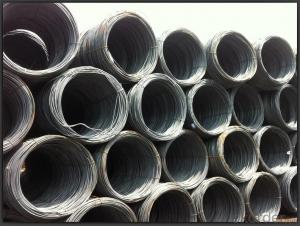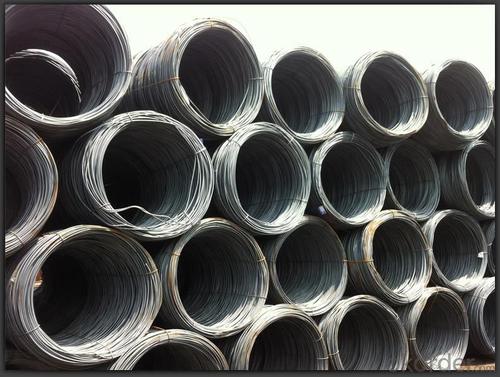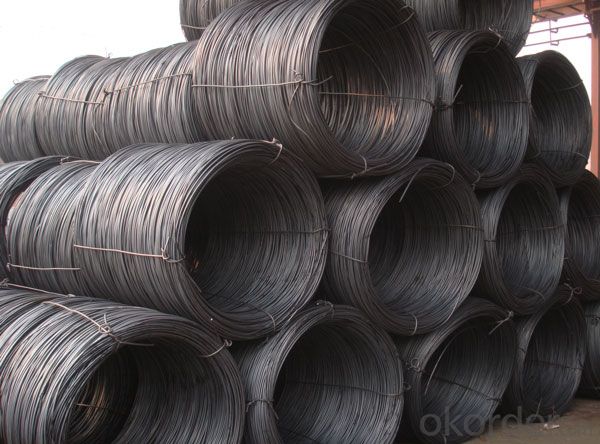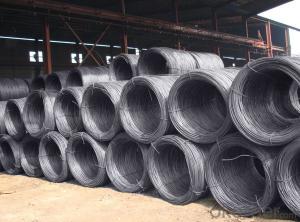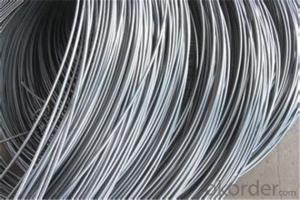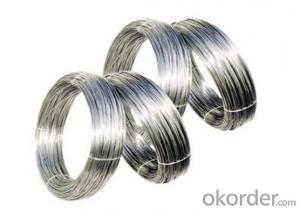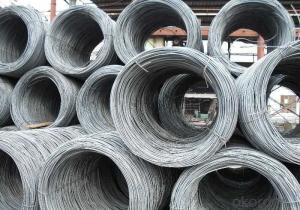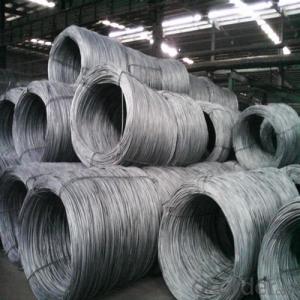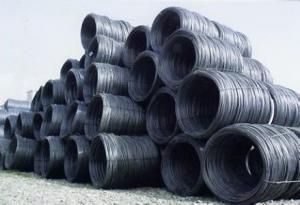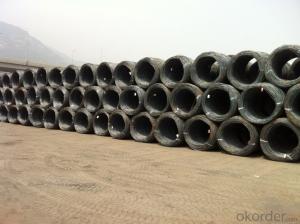Hot Rolled Wire Rod High Quality SAE 1006
- Loading Port:
- Shanghai
- Payment Terms:
- TT OR LC
- Min Order Qty:
- 25 m.t.
- Supply Capability:
- 200000 m.t./month
OKorder Service Pledge
OKorder Financial Service
You Might Also Like
Product Description:
OKorder is offering Hot Rolled Wire Rod High Quality SAE 1006 at great prices with worldwide shipping. Our supplier is a world-class manufacturer of steel, with our products utilized the world over. OKorder annually supplies products to European, North American and Asian markets. We provide quotations within 24 hours of receiving an inquiry and guarantee competitive prices.
Product Applications:
Carbon steel wire rod is widely used in construction and manufacturing. Carbon steel wire rod is mainly used for reinforcement of reinforced concrete and welded structure or reprocessed (roberts , nail, etc.) materials, especially used to produce wire drawing, welding electrode, nails, spring, electronic, precise machinery parts and so on.
Product Advantages:
OKorder's Hot Rolled Wire Rod High Quality SAE 1006 are durable, strong, and resist corrosion.
Main Product Features:
· Premium quality
· Prompt delivery & seaworthy packing (30 days after receiving deposit)
· Corrosion resistance
· Can be recycled and reused
· Mill test certification
· Professional Service
· Competitive pricing
Product Specifications:
Manufacture: Hot rolled
Grade: SAE1008 SAE 1006
Certificates: ISO, SGS, BV, CIQ
Diameter: 5.5mm, 6.5mm, 7mm,8mm,9mm,10mm,12mm,14mm, as per customer request
Packaging: Export packing, nude packing, bundled
Grade | Chemical Composition (%) | |||||
C | Mn | S | P | Si | B | |
SAE1008B | 0.10max | 0.32max | 0.045max | 0.040max | 0.30max | 0.0008min |
Mechanical properties | ||||||
Yield strength(N/mm2) | Tensile strength(N/mm2) | Elongation (%) | ||||
≥195 | 350-380 | ≥32 | ||||
FAQ:
Q1: The wire rod is added boron or chrom?
A1: We will choose to provide wire rod added chrom or boron according to the application of wire rod which the customer need.
Q2: How soon can we receive the product after purchase?
A2: Within three days of placing an order, we will begin production. The specific shipping date is dependent upon international and government factors, but is typically 7 to 10 workdays.
Q3: What makes stainless steel stainless?
A3: Stainless steel must contain at least 10.5 % chromium. It is this element that reacts with the oxygen in the air to form a complex chrome-oxide surface layer that is invisible but strong enough to prevent further oxygen from "staining" (rusting) the surface. Higher levels of chromium and the addition of other alloying elements such as nickel and molybdenum enhance this surface layer and improve the corrosion resistance of the stainless material.
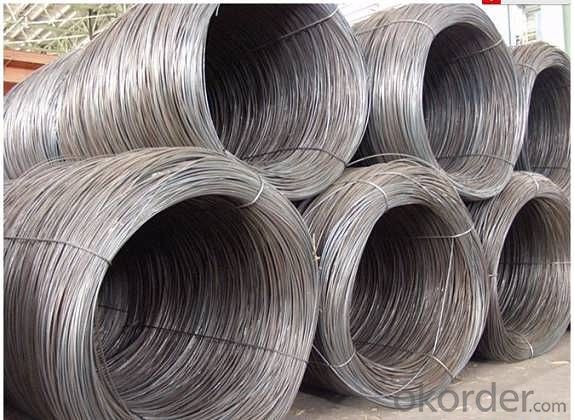
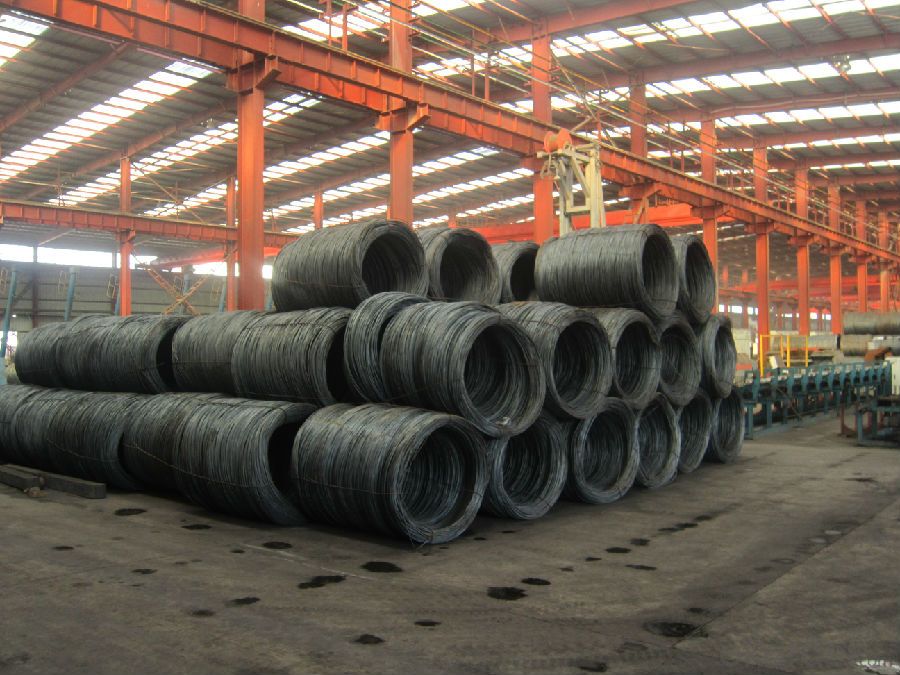
- Q: What are the different types of steel wire rod surface cleaning methods for wire drawing?
- There are several different types of steel wire rod surface cleaning methods that are commonly used in the wire drawing process. These methods are essential for removing any impurities or contaminants from the surface of the wire rod, ensuring a smooth and high-quality finished product. 1. Acid Pickling: Acid pickling is one of the most widely used methods for cleaning steel wire rod surfaces. This process involves immersing the wire rod in a bath of acid, typically hydrochloric acid, which helps to remove any rust, scale, or oxide layers. Acid pickling is effective in removing surface impurities and provides a clean surface for subsequent wire drawing processes. 2. Electrolytic Cleaning: Electrolytic cleaning is another commonly used method for removing contaminants from steel wire rod surfaces. In this process, an electric current is passed through the wire rod immersed in an electrolytic solution. The current causes the contaminants to dissolve and separate from the surface of the wire rod. Electrolytic cleaning can effectively remove oils, greases, and other organic substances from the wire rod surface. 3. Mechanical Cleaning: Mechanical cleaning methods involve the use of abrasive materials or brushes to physically scrub and clean the surface of the wire rod. This process can be done manually or using specialized machinery. Mechanical cleaning is effective in removing stubborn dirt, rust, or scale from the wire rod surface. 4. Shot Blasting: Shot blasting is a process that involves propelling small metallic or non-metallic particles against the wire rod surface at high speeds. The impact of the particles helps to remove any surface contaminants, scale, or rust. Shot blasting is particularly useful for cleaning wire rods with intricate shapes or hard-to-reach areas. 5. Ultrasonic Cleaning: Ultrasonic cleaning utilizes high-frequency sound waves to create tiny bubbles in a cleaning solution. The bubbles collapse upon contact with the wire rod surface, creating a scrubbing action that helps to remove contaminants. Ultrasonic cleaning is effective in removing fine particles, oils, and greases from the wire rod surface. Each of these steel wire rod surface cleaning methods has its advantages and limitations, and the choice of method depends on factors such as the type of contaminants, wire rod composition, and desired cleanliness level. The selection of the appropriate cleaning method is crucial to ensure optimal wire drawing performance and the production of high-quality wire products.
- Q: How is steel wire rod used in the manufacturing of wire forms for ski lifts?
- Steel wire rod is used in the manufacturing of wire forms for ski lifts as it provides the necessary strength and durability required for supporting the weight of the ski lift cabins and passengers. The wire rod is typically shaped and formed into various components such as cables, ropes, and pulleys which are then assembled to create a secure and reliable system for transporting skiers up the slopes.
- Q: How is steel wire rod used in automotive applications?
- Steel wire rods are extensively used in automotive applications due to their high strength, durability, and flexibility. They are primarily used in the manufacturing of various automotive components such as springs, cables, tires, and reinforcements. Steel wire rods are also used in seat frames, exhaust systems, and suspension systems, where their excellent tensile strength and resistance to corrosion play a crucial role in ensuring the safety and performance of vehicles. Overall, steel wire rods are an essential material in the automotive industry, contributing to the overall strength, reliability, and functionality of automobiles.
- Q: What are the main competitors of steel wire rod?
- Some of the main competitors of steel wire rod include aluminum wire rod, copper wire rod, and stainless steel wire rod.
- Q: What are the common applications of oil tempered and quenched steel wire rod?
- Oil tempered and quenched steel wire rod possesses unique properties, making it a commonly used material across various industries. Below are some of its widespread applications: 1. Springs: The extensive utilization of oil tempered and quenched steel wire rod can be observed in the production of springs, particularly those requiring high strength and durability. This material exhibits excellent resistance to fatigue, allowing the springs to endure repeated loading and unloading cycles without failure. 2. Mechanical parts: The high tensile strength and toughness of oil tempered and quenched steel wire rod render it suitable for various mechanical parts that necessitate reliability and resistance to wear and tear. These parts include bearings, gears, shafts, and other components found in machinery and equipment. 3. Automotive industry: The automotive industry widely employs oil tempered and quenched steel wire rod for various applications. It is utilized in the fabrication of suspension springs, valve springs, clutch springs, and other components that demand both strength and elasticity. 4. Construction industry: Due to its exceptional strength and corrosion resistance, oil tempered and quenched steel wire rod finds numerous applications in the construction sector. It is commonly employed for reinforcing concrete structures, such as pre-stressed concrete beams and columns, as well as for manufacturing various types of wire mesh and fencing. 5. Wire ropes and cables: Oil tempered and quenched steel wire rod frequently serves as the core material in wire ropes and cables. Its remarkable combination of strength, flexibility, and resistance to fatigue makes it ideal for applications involving heavy lifting, towing, or suspension, such as cranes, elevators, and suspension bridges. 6. Oil and gas industry: The oil and gas industry heavily relies on oil tempered and quenched steel wire rod for diverse applications. It is utilized in the fabrication of downhole tools, such as drill pipes and sucker rods, as well as for wirelines and control cables, which play a crucial role in exploration and production operations. In conclusion, oil tempered and quenched steel wire rod exhibits versatility and finds applications across a wide range of industries. Its strength, durability, and resistance to fatigue and corrosion make it the preferred choice for various applications, including springs, mechanical parts, automotive components, construction materials, wire ropes, and numerous oil and gas industry applications.
- Q: What are the main factors affecting the product differentiation of steel wire rod?
- The main factors affecting the product differentiation of steel wire rod are the chemical composition and quality of the steel used, the manufacturing process and technology employed, the size and shape options available, the surface finish and treatment, and any additional features or value-added services provided by the manufacturer.
- Q: What are the different types of surface finishes available for steel wire rod?
- Steel wire rod has several options for surface finishes, each with its own purpose and characteristics. These finishes are applied during manufacturing to enhance properties and performance. The most common surface finish for steel wire rod is the bright finish. This involves a mechanical process that removes scale and oxide layers, resulting in a smooth and shiny appearance. Bright finish is used when high corrosion resistance is needed. Another option is the black finish, also known as hot-rolled or pickled finish. This is achieved by allowing the wire rod to cool naturally after rolling, resulting in a dark, rough, and scaly appearance due to oxide layers. Black finish is commonly used for low-cost applications where corrosion resistance is not a major concern. For excellent corrosion resistance, the galvanized finish is applied. This involves coating the wire rod with a layer of zinc through hot-dip galvanizing or electroplating. It creates a shiny and protective layer on the surface, making it suitable for outdoor applications or environments with high humidity or exposure to chemicals. Phosphate finish is achieved through a chemical process called phosphating. This creates a thin phosphate coating on the surface, improving lubricant or paint adhesion and enhancing corrosion resistance. Phosphate finish is commonly used in applications requiring lubrication, such as automotive or industrial machinery. Alternatively, steel wire rod can be coated with materials like polymer or enamel to provide additional protection and improve specific properties. Coated finishes offer benefits such as increased corrosion resistance, improved electrical conductivity, or enhanced aesthetics. They are commonly used in fencing, electrical wiring, or decorative applications. In conclusion, steel wire rod can have bright, black, galvanized, phosphate, or coated finishes. Each finish serves a specific purpose and provides unique characteristics, allowing the wire rod to meet various performance requirements in different applications.
- Q: How is steel wire rod used in the manufacturing of automotive springs?
- Steel wire rod is used in the manufacturing of automotive springs as it provides the necessary strength and durability required for suspension systems. The wire rod is typically formed into coils and then further processed to create the desired shape and size of the spring. These springs play a critical role in supporting the weight of the vehicle, providing stability, and absorbing shocks and vibrations, ensuring a smooth and safe ride.
- Q: How is steel wire rod processed to achieve specific properties?
- Steel wire rod is processed through a series of manufacturing steps to achieve specific properties that make it suitable for various applications. The process begins with the selection of high-quality raw materials, typically low carbon steel, which is melted in a furnace to create molten steel. Once the molten steel is produced, it is then continuously cast into billets or blooms, which are solidified and then rolled into wire rod form through hot rolling. This hot rolling process involves passing the billets or blooms through a series of rollers to reduce their size and shape them into the desired wire rod dimensions. This step helps align the grain structure of the steel, improving its strength and ductility. After hot rolling, the wire rod undergoes a cooling process to relieve any residual stress and ensure dimensional stability. It is then subjected to a surface treatment, such as pickling or shot blasting, to remove any oxides or scale formed during the hot rolling process. To achieve specific mechanical properties, the wire rod may undergo further processing steps, such as cold drawing or heat treatment. Cold drawing involves pulling the wire rod through a series of dies to reduce its diameter, increase its tensile strength, and improve its surface finish. Heat treatment, on the other hand, involves subjecting the wire rod to controlled heating and cooling cycles to modify its microstructure, resulting in desired properties like hardness, toughness, or corrosion resistance. Additionally, the wire rod may undergo additional surface treatments, such as coating or galvanizing, to enhance its corrosion resistance or improve its aesthetic appearance. Coating can involve applying a layer of zinc, polymer, or other protective materials, while galvanizing involves immersing the wire rod in a bath of molten zinc to create a protective zinc coating. Overall, the processing of steel wire rod involves a combination of hot rolling, cooling, surface treatment, and potential further processing steps like cold drawing or heat treatment. These steps are carefully implemented to achieve specific properties, such as strength, ductility, corrosion resistance, and surface finish, making the wire rod suitable for diverse applications in industries like construction, automotive, manufacturing, and more.
- Q: What are the different ductility testing methods for steel wire rod?
- Steel wire rods can be assessed for ductility using various testing methods. These methods measure the material's ability to deform under tensile stress without breaking. Some commonly used tests for steel wire rods include: 1. Tensile Test: This is the most frequently employed method for evaluating ductility. It involves subjecting a wire rod specimen to increasing tensile force until it fractures. The elongation and reduction in area of the specimen are measured to determine its ductility. 2. Bend Test: This test assesses the material's ability to withstand bending without cracking or fracturing. A wire rod specimen is bent to a predetermined angle, and any visible defects or changes are documented to evaluate its ductility. 3. Cupping Test: This test determines the deep-drawing quality of steel wire rods. A specimen is deformed into a cup shape using a die and punch. The material's ability to undergo deformation without cracking or tearing indicates its ductility. 4. Charpy Impact Test: While primarily used for measuring toughness, this test also provides insights into the ductility of steel wire rods. A notched specimen is subjected to a high-velocity impact, and the energy absorbed during fracture is measured. Higher energy absorption suggests good ductility. 5. Fatigue Test: This test indirectly assesses the ductility of steel wire rods by evaluating their fatigue resistance. The specimen is subjected to repeated cyclic loading until failure, and the number of cycles required is recorded. Materials with high ductility are expected to have better fatigue resistance. These testing methods offer valuable information about the ductility properties of steel wire rods, aiding engineers and manufacturers in selecting the most suitable material for specific applications.
Send your message to us
Hot Rolled Wire Rod High Quality SAE 1006
- Loading Port:
- Shanghai
- Payment Terms:
- TT OR LC
- Min Order Qty:
- 25 m.t.
- Supply Capability:
- 200000 m.t./month
OKorder Service Pledge
OKorder Financial Service
Similar products
Hot products
Hot Searches
Related keywords
